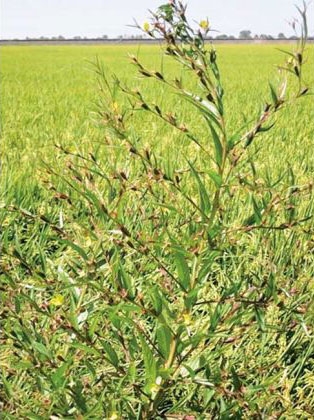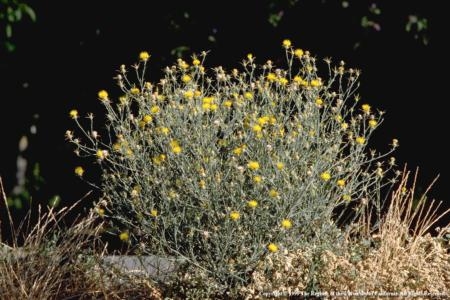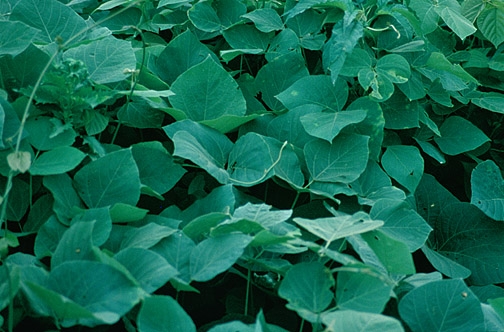Posts Tagged: Weeds
The Mayapple
On a recent trip to the Midwest, I came across one of their native plants. This plant has a variety of names depending on the part of the Midwest it grows in. I was in Missouri and there it is called Mayapple (Podophyllum peltatum), in other parts of the Midwest it may be called May pop, devils apple, raccoon berry, just to name a few. In researching this plant I found it is a member of the Berberidaceae family.
The Mayapple is an unusual plant. It grows in the woods and areas that stay wet most of the year. The one I saw was at the edge of woods not far from a running creek. It is a low growing plant that appears to spread maybe by rhizomes, because of where it was growing it was hard to tell as there was poison ivy growing there as well.
When it is still young it has a single stem with one large umbrella looking leaf. As it ages, which usually is sometime in April, the leaf and stem split creating 2 leaves and 2 stems the flower. You have to look for is in the bottom part of the 2 stems that come together. Since the weather in Missouri is unusual this year, the plant is late in blooming, so the split had not happened when I was there.
I was told that the flower hides underneath the leaves until the stem grows a stalk 12-18 inches tall. It is only then the large white flower appears. After the flower fades large yellow fruit appear. The fruit is said to be edible, but only when it is fully ripe, which is when they have lost their green color, but I would not advise eating it. If consumed in large amounts, the danger of toxicity occurs. NOTE: UC Master Gardeners do not recommend eating anything without proper identification by a professional botanist.

The Mayapple long before it flowers. (photo by Pat Greer)
Invasive weed threatens California rice
The weed is highly invasive, produces vast quantities of seeds and survives under a wide range of hydrological and climatic conditions.
"Farmers have to keep an eye out for this weed, and let us know if they think they have it," said Luis Espino, UC Cooperative Extension advisor in Colusa, Glenn and Yolo counties, a rice production expert.
Unlike other waterprimroses, the winged primrose willow can grow within flooded rice fields, which makes it even more problematic for local farmers if it should get established in this area, Espino said.
New technologies offer promising options for organic weed control
Poets have romantically suggested that a “weed is no more than a flower in disguise.” But when burning nettle, pigweed and purslane rob water, sunlight and nutrients from vegetables you are growing to make a living, weeds are a despised nemesis.
For conventional growers, chemical herbicides have taken the drudgery out of weed control. For organic farmers, weeds continue to be a perennial headache.
Many large-scale organic growers have turned to mechanical cultivators to dislodge weeds. However, standard cultivation systems leave an untouched band of soil around the seedlings that must be cleared by hand. This hand labor often represents a large part of total production expenses.
Richard Smith, a UC Cooperative Extension advisor in Monterey County who specializes in vegetable production and weed control, heard about “finger weeders” while at a conference in Germany.
“There is a brand available in the U.S., but the European design is much better,” Smith said.
He purchased a finger weeder from the German Kress Company and conducted trials on commercial farms in Monterey County to assess their effectiveness in organic vegetable production. With this system, hard plastic discs with long fingers are pulled by a tractor horizontally down the field, dislodging recently germinated weeds while leaving transplanted vegetables unharmed.
The timing of cultivation is critical. For transplanted vegetables, the cultivation must be done after the plants are firmly rooted and weed seedlings have just one small, tender root. Soil moisture also influences the effectiveness of the finger weeder.
In a trial Smith conducted on organic leeks, the finger weeder removed 80 percent of weeds, while the standard cultivator removed 29 percent. Hand weeding time was reduced by 45 percent, from 19 hours per acre to 10 hours per acre. The yield of the leeks was not affected by the finger weeder cultivation.
On an organic radicchio farm, the finger weeder removed 81 percent of weeds, while the standard cultivator reduced 48 percent. Hand weeding time was reduced 44 percent, and the yield was unaffected.
In six out of eight trials, the finger weeder significantly reduced hand weeding time compared to standard cultivation.
“We want to raise awareness among our growers that this is a viable option for weed control on organic farms,” Smith said.
Smith is also studying other high-technology organic weed control systems, such as computer-guided cultivation equipment.
“There is tremendous potential in this technology, but it is very expensive,” Smith said.
For more information on organic weeding options, see the video below:
Collaboration may be an effective way to fund wildland weed control
Many funding sources for weed eradication have been reduced or completely eliminated. According to the California Assembly Budget Committee’s annual Preliminary Review of the Governor’s Proposed 2012-13 State Budget, the California Department of Food and Agriculture will absorb a permanent budget reduction of $12 million in program cuts, in addition to a $19 million budget reduction in 2011-12. Funding for weed management areas (WMAs) has been reduced to the point that many WMAs have become inactive or are being managed voluntarily as an adjunct to other duties.
At the California Invasive Plant Council (Cal-IPC: http://www.cal-ipc.org/) annual symposium at Lake Tahoe in October, it was stressed that competition for limited funding will pit us against ourselves and each other. Only by working together, creating collaborative projects, will we be able to benefit from the limited funding opportunities available.
Enter the collaborative grant-funded project. Agencies are looking for applications that demonstrate community support from a diverse range of stakeholders. For example, the Sierra Nevada Conservancy (SNC) is currently reviewing proposals received in response to their Healthy Forests initiative. Proposition 84 — The Safe Drinking Water, Water Quality and Supply, Flood Control, River and Coastal Protection Bond Act of 2006 — will fund approved projects. Five million dollars is available this year for healthy forest projects; next year an equal amount will be available for rangeland projects.
Two weed control projects created by UC Cooperative Extension Central Sierra received SNC invitations to submit complete grant applications. One project is a collaboration between UCCE, the U.S. Forest Service, and Yosemite National Park; another works in partnership with Cal-IPC.
As an example of the collaborative partnerships being sought by funding agencies, the National Fish and Wildlife Foundation is offering the ‘Pulling Together Initiative’ which “seeks proposals that will help control invasive plant species, mostly through the work of public/private partnerships such as Cooperative Weed Management Areas.” Successful projects must “have a project Steering Committee composed of local cooperators who are committed to working together to manage invasive and noxious plants across their jurisdictional boundaries.”
Clearly, in light of decreased federal and state funding, a strategic direction for weed-control projects will be to leverage resources, working together to do what no one agency can accomplish alone.
Two additional collaborative projects, created by Wendy West of UCCE Central Sierra, are highlighted here:
- A Weed-Free Forage List providing California resources for weed-free feed and erosion control materials will soon be posted on Cal-IPC’s website. The site will also contain explanatory information about weed-free certification, along with links to inspection procedures and noxious weed lists.
- Workshops designed to help prevent the spread of weeds during construction, aggregate production and maintenance activities are being offered throughout the state. The workshop is hosted and sponsored by U.S. Forest Service, National Park Service, California Department of Food and Agriculture, University of California and University of Nevada Cooperative Extension, and the California Invasive Plant Council.
A Fresno County workshop was held in January and a sold-out workshop is scheduled for March in Los Angeles County. If you are located in the central California region that includes Amador, Calaveras, El Dorado, Madera, Mariposa, San Joaquin, Stanislaus or Tuolumne counties, please consider attending the next workshop, scheduled for April 9 in Sonora. The final workshop will be held in Truckee on May 2. Register for the workshops here.
Prevention Workshop 2012 flier
Workshop Schedule.Agenda
UC farm advisor outlines problems posed by invasive species
Faber said invasive species are being introduced at a rapid rate around the world, and are primarily spread by humans.
He differentiated between non-native plants that are beneficial, such as avocados and citrus, and invasive plants that have been accidentally introduced into an ecosystem where they run rampant.
"An invasive species is something out of place and out of control," he said.
Fresno State report confirms state’s farmers apply water efficiently
Fresno State press release
Claims that California farmers are wasteful and inefficient in managing their water supplies are inaccurate, according to a new report released by Fresno State's Center for Irrigation Technology.
The study is the culmination of a yearlong effort by irrigation experts to update the 1982 University of California Cooperative Extension report “Agricultural Water Conservation in California with Emphasis on the San Joaquin Valley” by David C. Davenport and Robert M. Hagan.
The new study concludes that the 1982 report correctly framed the potential for agricultural water-use efficiency, and many of its findings are still relevant 30 years later.





